SKODA OCTAVIA 2009 2.G / (1Z) Owner's Manual
Manufacturer: SKODA, Model Year: 2009, Model line: OCTAVIA, Model: SKODA OCTAVIA 2009 2.G / (1Z)Pages: 304, PDF Size: 19.56 MB
Page 171 of 304
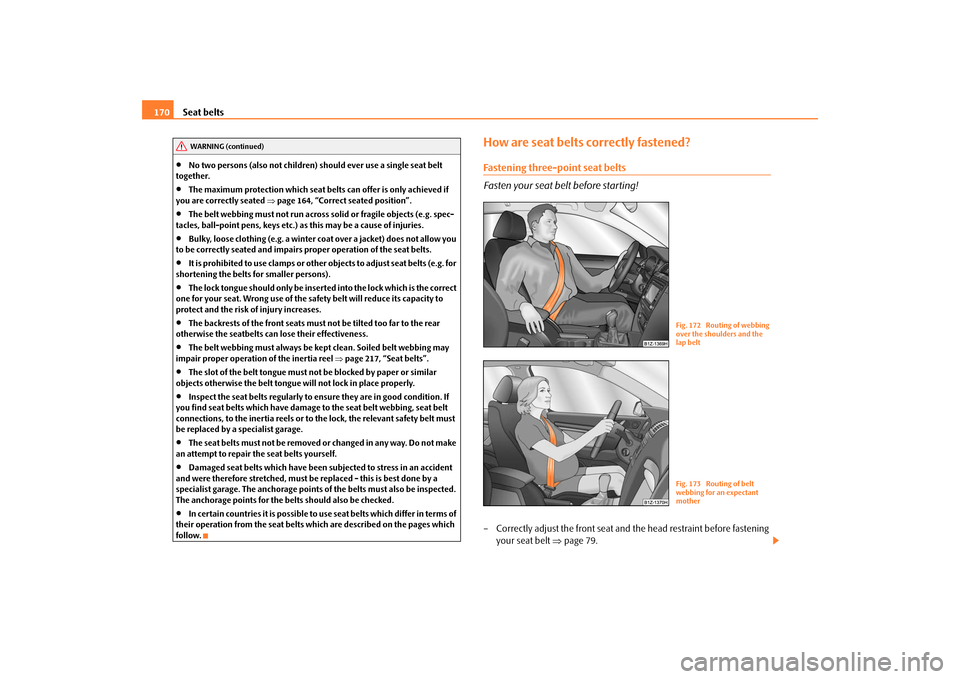
Seat belts
170
•
No two persons (also not children) should ever use a single seat belt
together.•
The maximum protection which seat belts can offer is only achieved if
you are correctly seated
⇒page 164, “Correct seated position”.
•
The belt webbing must no
t run across solid or fragile objects (e.g. spec-
tacles, ball-point pens, keys etc.) as this may be a cause of injuries.•
Bulky, loose clothing (e.g. a winter coat over a jacket) does not allow you
to be correctly seated and impairs proper operation of the seat belts.•
It is prohibited to use clamps or other objects to adjust seat belts (e.g. for
shortening the belts for smaller persons).•
The lock tongue should only be insert
ed into the lock which is the correct
one for your seat. Wrong use of the safety belt will reduce its capacity to protect and the risk of injury increases.•
The backrests of the front seats must not be tilted too far to the rear
otherwise the seatbelts can
lose their effectiveness.
•
The belt webbing must always be ke
pt clean. Soiled belt webbing may
impair proper operation of the inertia reel
⇒page 217, “Seat belts”.
•
The slot of the belt tongue must not be blocked by paper or similar
objects otherwise the belt tongue will not lock in place properly.•
Inspect the seat belts regu
larly to ensure they are
in good condition. If
you find seat belts which have damage to the seat belt webbing, seat belt connections, to the inertia reels or to the lock, the relevant safety belt must be replaced by a specialist garage.•
The seat belts must not be removed or changed in any way. Do not make
an attempt to repair the seat belts yourself.•
Damaged seat belts which have been subjected to stress in an accident
and were therefore stretched, must be replaced - this is best done by a specialist garage. The anchorage points
of the belts must also be inspected.
The anchorage points for the be
lts should also be checked.
•
In certain countries it is possible to use seat belts which differ in terms of
their operation from the seat belts wh
ich are described on the pages which
follow.
How are seat belts correctly fastened?Fastening three-point seat belts Fasten your seat belt before starting!– Correctly adjust the front seat and
the head restraint before fastening
your seat belt
⇒
page 79.
WARNING (continued)
Fig. 172 Routing of webbing over the shoulders and the lap beltFig. 173 Routing of belt webbing for an expectant mother
se0.1.book Page 170 Frida
y, April 10, 2009 3:19 PM
Page 172 of 304

Seat belts
171
Using the system
Safety
Driving Tips
General Maintenance
Breakdown assistance
Technical Data
– Slowly pull the belt webbing at the to
ngue of the lock over your chest
and pelvis
⇒
.
– Insert the tongue of the lock into th
e seat belt buckle belonging to the
seat until it is heard to lock in place.
– Pull on the belt to check that it has also reliably engaged in the lock.Each three-point seat belt is equipped with an inertia reel. This inertia reel offers you complete freedom of movement if the
belt is unreeled slowly. If the brakes are
applied suddenly, the inertia reel will block. It also blocks the belts when the car accelerates, when driving uphill and when cornering. Expectant mothers must also wear the seat belt
⇒
.
WARNING
•
The shoulder part of the seat belt must never run across your neck but
must run approximately over the middl
e of the shoulder and fit snugly
against the chest. The lap part of the
belt must run across the hip and must
never be routed across the stomach. It must always fit snugly
⇒page 170,
fig. 172
. Adjust the belt webbing as required.
•
The lap part of the belt should be positioned as low as possible at the
pelvis of an expectant mother in order to avoid exerting any pressure on the lower abdomen
⇒page 170, fig. 173
.
•
Always ensure that the webbing of the
seat belts is properly routed. Seat
belts which are not correctly adjusted ca
n themselves cause injuries even in
minor accidents.•
A seat belt which is hanging too loose can result in injuries as your body
is moved forward by the kinetic energy produced in an accident and is then suddenly held firm by the belt.•
Only insert the lock tongue into the lo
ck which is the correct one for your
seat. This will affect the protection whic
h the belt offers and increase the risk
of an injury.
Seat belt height adjusterThe seat belt height adjuster makes it possible for you to adapt the routing of the three-point seat belt in
the area of the shoulder to match
your body size. – Move the height adjuster in the desired direction up or down
⇒
fig. 174
.
– Then pull firmly on the belt to ensure
that the seat belt height adjuster
has correctly locked in place.
WARNING
Adjust the height of the belt in such a way that the shoulder part of the belt is positioned approximately across the middle of your shoulder - on no account across your neck.
Note
It is also possible to adapt the routing
of the belt webbing at the front seats by
adjusting the height of the seat.
Fig. 174 Front seat: Seat belt height adjuster
se0.1.book Page 171 Frida
y, April 10, 2009 3:19 PM
Page 173 of 304
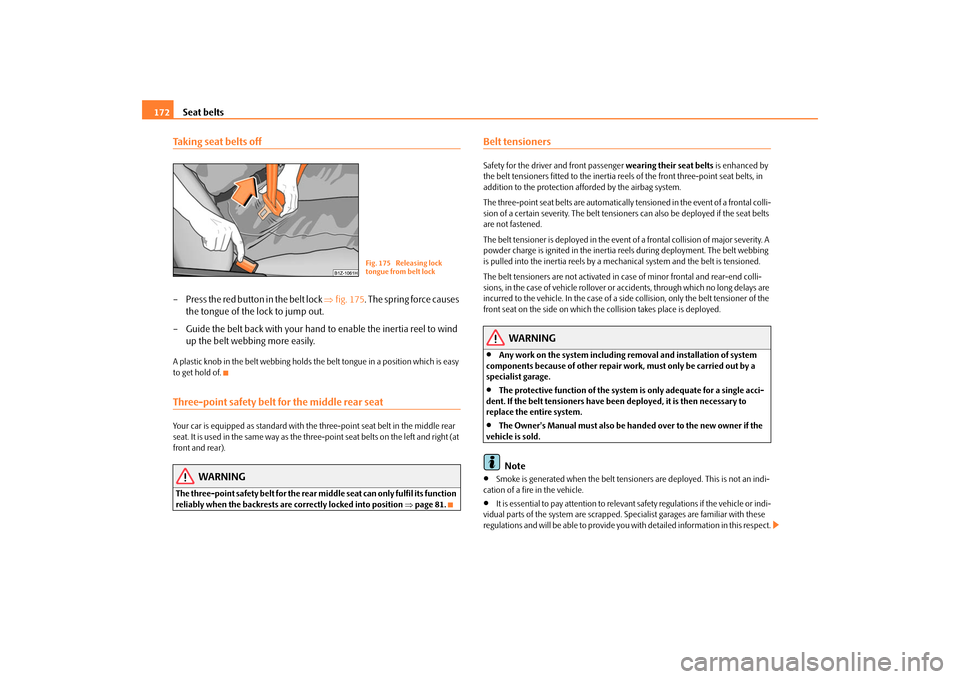
Seat belts
172
Taking seat belts off– Press the red button in the belt lock
⇒
fig. 175
. The spring force causes
the tongue of the lock to jump out.
– Guide the belt back with your hand
to enable the inertia reel to wind
up the belt webbing more easily.
A plastic knob in the belt webbing holds the belt tongue in a position which is easy to get hold of.Three-point safety belt for the middle rear seatYour car is equipped as standa
rd with the three-point seat belt in the middle rear
seat. It is used in the same way as the three-point seat belts on the left and right (at front and rear).
WARNING
The three-point safety belt for the rear middle seat can only fulfil its function reliably when the backrests are correctly locked into position
⇒page 81.
Belt tensionersSafety for the driver and front passenger
wearing their seat belts
is enhanced by
the belt tensioners fitted to the inertia re
els of the front three-point seat belts, in
addition to the protection af
forded by the airbag system.
The three-point seat belts are automatically
tensioned in the event of a frontal colli-
sion of a certain severity. The belt tensione
rs can also be deployed if the seat belts
are not fastened. The belt tensioner is deployed in the event
of a frontal collision of major severity. A
powder charge is ignited in the inertia
reels during deployment. The belt webbing
is pulled into the inertia reels by a mech
anical system and the belt is tensioned.
The belt tensioners are not activated in
case of minor frontal and rear-end colli-
sions, in the case of vehicle rollover or accidents, through which no long delays are incurred to the vehicle. In the case of a side collision, only the belt tensioner of the front seat on the side on which th
e collision takes place is deployed.
WARNING
•
Any work on the system including removal and installation of system
components because of other repair work, must only be carried out by a specialist garage.•
The protective function of the system is only adequate for a single acci-
dent. If the belt tensioners have been deployed, it is then necessary to replace the entire system.•
The Owner's Manual must also be ha
nded over to the new owner if the
vehicle is sold.
Note
•
Smoke is generated when the belt tensione
rs are deployed. This is not an indi-
cation of a fire in the vehicle.•
It is essential to pay attention to relevant
safety regulations if the vehicle or indi-
vidual parts of the system are scrapped. Specialist garages are familiar with these regulations and will be able to provide you
with detailed information in this respect.
Fig. 175 Releasing lock tongue from belt lock
se0.1.book Page 172 Frida
y, April 10, 2009 3:19 PM
Page 174 of 304

Seat belts
173
Using the system
Safety
Driving Tips
General Maintenance
Breakdown assistance
Technical Data
•
When disposing of vehicle or parts of the system, it is important to comply with
the national legal requirements.
se0.1.book Page 173 Frida
y, April 10, 2009 3:19 PM
Page 175 of 304
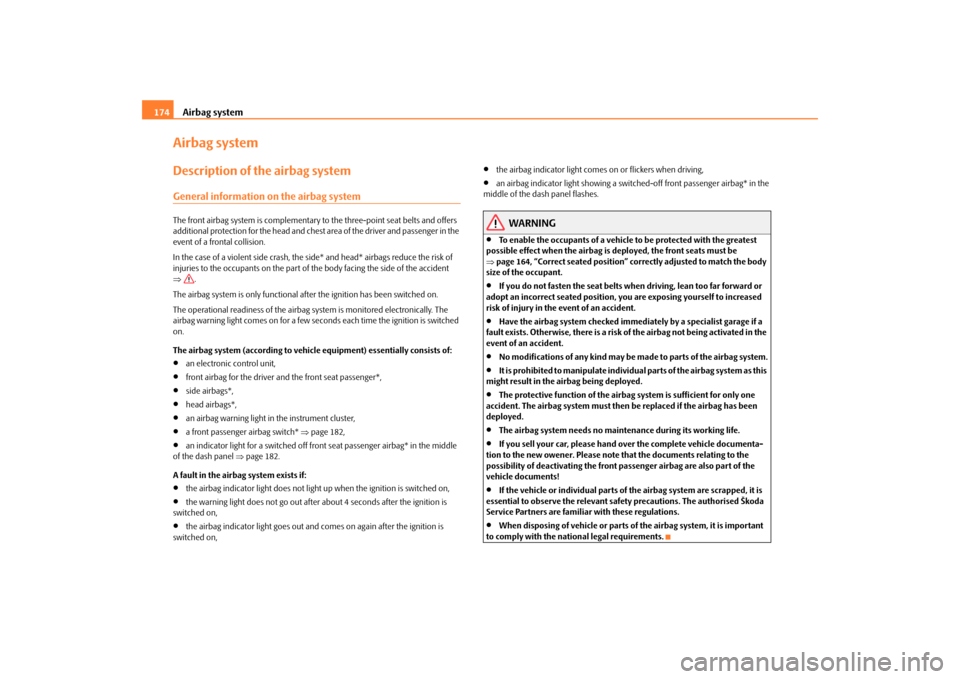
Airbag system
174
Airbag systemDescription of the airbag systemGeneral information on the airbag systemThe front airbag system is complementary to the three-point seat belts and offers additional protection for the head and ches
t area of the driver and passenger in the
event of a frontal collision. In the case of a violent side crash, the si
de* and head* airbags reduce the risk of
injuries to the occupants on
the part of the body facing
the side of the accident
⇒
.
The airbag system is only functional after the ignition has been switched on.The operational readiness of the airbag system is monitored electronically. The airbag warning light comes on for a few seconds each time the ignition is switched on. The airbag system (according to vehicl
e equipment) essent
ially consists of:
•
an electronic control unit,
•
front airbag for the driver and the front seat passenger*,
•
side airbags*,
•
head airbags*,
•
an airbag warning light in the instrument cluster,
•
a front passenger airbag switch*
⇒page 182,
•
an indicator light for a switched off fron
t seat passenger airbag* in the middle
of the dash panel
⇒page 182.
A fault in the airbag system exists if:•
the airbag indicator light does not light
up when the ignition is switched on,
•
the warning light does not go out after about 4 seconds after the ignition is
switched on,•
the airbag indicator light goes out and comes on again after the ignition is
switched on,
•
the airbag indicator light comes on or flickers when driving,
•
an airbag indicator light showing a swit
ched-off front passenger airbag* in the
middle of the dash panel flashes.
WARNING
•
To enable the occupants of a vehicle to be protected with the greatest
possible effect when the airbag is deployed, the front seats must be ⇒ page 164, “Correct seated position” co
rrectly adjusted to match the body
size of the occupant.•
If you do not fasten the seat belts when driving, lean too far forward or
adopt an incorrect seated position, you are exposing yourself to increased risk of injury in the event of an accident.•
Have the airbag system checked imme
diately by a specialist garage if a
fault exists. Otherwise, there is a risk of the airbag not being activated in the event of an accident. •
No modifications of any kind may be made to parts of the airbag system.
•
It is prohibited to manipulate individual parts of the airbag system as this
might result in the airbag being deployed.•
The protective function of the airbag system is sufficient for only one
accident. The airbag system must then
be replaced if the airbag has been
deployed.•
The airbag system needs no maintenance during its working life.
•
If you sell your car, please hand over the complete vehicle documenta-
tion to the new owener. Please note that the documents relating to the possibility of deactivating the front passenger airbag are also part of the vehicle documents!•
If the vehicle or individual parts of
the airbag system are scrapped, it is
essential to observe the relevant safety precautions. The authorised Škoda Service Partners are famili
ar with these regulations.
•
When disposing of vehicle or parts of the airbag system, it is important
to comply with the national legal requirements.
se0.1.book Page 174 Frida
y, April 10, 2009 3:19 PM
Page 176 of 304

Airbag system
175
Using the system
Safety
Driving Tips
General Maintenance
Breakdown assistance
Technical Data
When are the airbags deployed?The airbag system is designed in such
a way that the driver and front passenger
airbag are deployed in the event of a
frontal collision
of major severity.
In the case of a
violent side crash
, the side airbag* on the side on which the colli-
sion occurs, is depl
oyed together with the head airbag*.
In certain accident situa
tions, the front airbags, side airbags as well as the relevant
head airbag may be
deployed together.
The airbags
are not deployed
in the case of
minor
frontal and side collisions, in the
case of rear-end collisi
ons and vehicle rollover.
Deployment factors It is not possible to state globally which
deployment conditions apply to the airbag
system in every situation as the circumstances which exist in the case of accidents vary greatly. An important role in this case
, for example, is played by factors such as
the type of object (hard, soft) against whic
h the vehicle impacts or the type of object
against which the vehicle impa
cts, the angle of impact,
the relative vehicle speed
during the accident etc. A decisive factor for the deployment of the airbags is the deceleration which occurs during a collision. The control unit analyses
the nature of the collision and activates
the relevant restraint system. If the vehi
cle deceleration which occurs and is meas-
ured during the collision remains below the prescribed reference values specified in the control unit, the airbags are not
deployed although the vehicle may well
suffer severe damage to the bodywork
as a consequence of the accident.
The airbags are not deployed if:•
ignition off,
•
a minor frontal collision,
•
a minor side collision,
•
a rear-end collision,
•
Rollover of the vehicle.
Note
•
A grey white, non harmful gas is released when airbag is inflated. This is
perfectly normal and is not an indi
cation of a fire in the vehicle.
•
In the event of an accident in which the airbags are deployed: − The interior lighting comes on (if the switch for the interior light is in the door contact position), − The hazard warning light is switched on, − All the doors are unlocked, − the fuel supply to the engine is interrupted.
Front airbagDescription of the front airbags The airbag system is not a substitute for the seat belt!
Fig. 176 Driver airbag in the steering wheel
se0.1.book Page 175 Frida
y, April 10, 2009 3:19 PM
Page 177 of 304
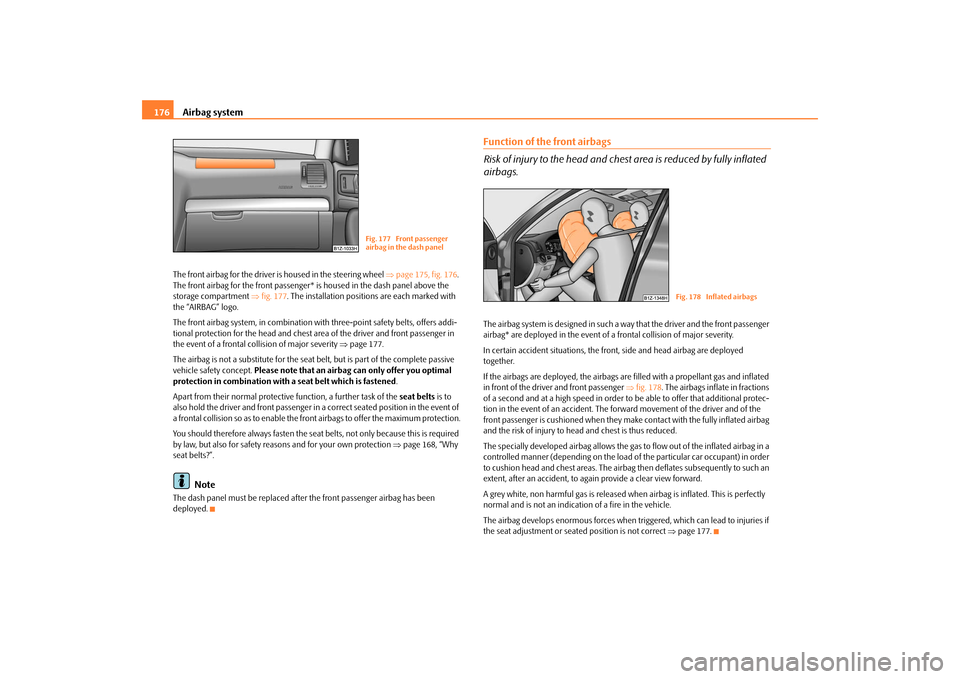
Airbag system
176
The front airbag for the driver is housed in the steering wheel
⇒page 175, fig. 176
.
The front airbag for the front passenger* is housed in the dash panel above the storage compartment
⇒fig. 177
. The installation positions are each marked with
the “AIRBAG” logo. The front airbag system, in combination with
three-point safety belts, offers addi-
tional protection for the head and chest ar
ea of the driver and front passenger in
the event of a frontal coll
ision of major severity
⇒page 177.
The airbag is not a substitute for the seat belt, but is part of the complete passive vehicle safety concept.
Please note that an airbag can only offer you optimal
protection in combination with a seat belt which is fastened
.
Apart from their normal protective function, a further task of the
seat belts
is to
also hold the driver and front passenger in
a correct seated position in the event of
a frontal collision so as to enable the fr
ont airbags to offer the maximum protection.
You should therefore always fasten the seat belts, not only because this is required by law, but also for safety reasons and for your own protection
⇒page 168, “Why
seat belts?”.
Note
The dash panel must be replaced afte
r the front passenger airbag has been
deployed.
Function of the front airbags Risk of injury to the head and chest area is reduced by fully inflated airbags.The airbag system is designed in such a way that the driver and the front passenger airbag* are deployed in the event of a frontal collision of major severity. In certain accident situations, the front,
side and head airbag are deployed
together. If the airbags are deployed, the airbags are
filled with a propellant gas and inflated
in front of the driver and front passenger
⇒fig. 178
. The airbags inflate in fractions
of a second and at a high speed in order to
be able to offer that additional protec-
tion in the event of an accident. The forward movement of the driver and of the front passenger is cushioned when they make
contact with the fully inflated airbag
and the risk of injury to head and chest is thus reduced. The specially developed airbag allows the gas to flow out of the inflated airbag in a controlled manner (depending on the load of
the particular car occupant) in order
to cushion head and chest areas. The airbag
then deflates subsequently to such an
extent, after an accident, to again provide a clear view forward. A grey white, non harmful gas is released when airbag is inflated. This is perfectly normal and is not an indicati
on of a fire in the vehicle.
The airbag develops enormous forces when triggered, which can lead to injuries if the seat adjustment or seat
ed position is not correct
⇒page 177.
Fig. 177 Front passenger airbag in the dash panel
Fig. 178 Inflated airbags
se0.1.book Page 176 Frida
y, April 10, 2009 3:19 PM
Page 178 of 304

Airbag system
177
Using the system
Safety
Driving Tips
General Maintenance
Breakdown assistance
Technical Data
Important safety information regarding the front airbag system Correct use of the airbag system considerably reduces the risk of injury!
WARNING
•
Never transport children on the front seat of a vehicle without using a
proper restraint system. If airbags are
deployed in the event of an accident,
the child might suffer severe or even fatal injuries!•
For the driver and front passenger it is important to maintain a distance
of at least 25 cm from the steering wheel or dash panel
⇒fig. 179
. Not main-
taining this minimum distance will mean that the airbag system will not be able to properly protect you - hazard!
The front seats and the head restraints
must always also be correctly adjusted to match the body size of the occu-pant.•
It is essential to always switch off
⇒page 181, “Deactivating an airbag”
the front passenger airbag when attach
ing a child safety seat on the front
passenger seat where the child is seated
with its back facing in direction of
travel (in some countries also when the ch
ild is facing the direction of travel).
If this is not done, there is a risk of
the child suffering severe or even fatal
injuries if the front passenger airbag
is deployed. In certain countries
national legal provisions also requir
e that the side or head passenger
airbags be deactivated. When transporting a child on the front passenger
seat, please comply with the appropriate national regulations regarding the use of child safety seats.•
There must not by any further persons, animals or objects positioned
between the front seated occupants and the deployment area of the airbag.•
The steering wheel and the surface of
the airbag module in the dash
panel on the passenger side must not be stuck onto, covered or modified in any other way. These parts should only be cleaned with a dry cloth or a cloth moistened with water. No objects such as cup holders, mobile phone mounts, etc. may be attached to the covers of the airbag modules or be located within the immediate area.•
No modifications of any kind may be made to parts of the airbag system.
Any work on the airbag system includ
ing installing and removing system
components because of other repair
work (e.g. removing the steering
wheel) must only be carried
out by a specialist garage.
•
Never carry out changes on the front bumper or on the body.
•
Never place any objects on the surface of the front passenger airbag in
the dash panel.
Fig. 179 Safe distance to steering wheel
WARNING (continued)
se0.1.book Page 177 Frida
y, April 10, 2009 3:19 PM
Page 179 of 304
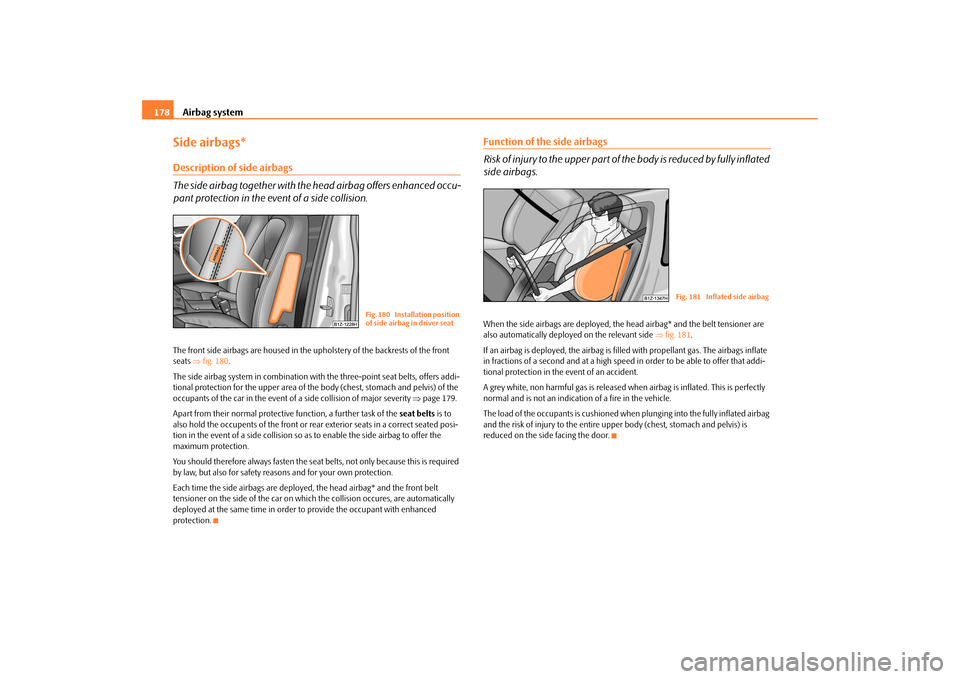
Airbag system
178
Side airbags*Description of side airbags The side airbag together with the he
ad airbag offers enhanced occu-
pant protection in the event of a side collision.The front side airbags are housed in the
upholstery of the backrests of the front
seats
⇒fig. 180
.
The side airbag system in combination with the three-point seat belts, offers addi- tional protection for the upper area of th
e body (chest, stomach and pelvis) of the
occupants of the car in the event of
a side collision of major severity
⇒page 179.
Apart from their normal protective function, a further task of the
seat belts
is to
also hold the occupents of the front or rear
exterior seats in a correct seated posi-
tion in the event of a side collision so as
to enable the side airbag to offer the
maximum protection. You should therefore always fasten the seat belts, not only because this is required by law, but also for safety reasons and for your own protection. Each time the side airbags are deployed, the head airbag* and the front belt tensioner on the side of the car on whic
h the collision occures, are automatically
deployed at the same time in order to
provide the occupant with enhanced
protection.
Function of the side airbags Risk of injury to the upper part of the body is reduced by fully inflated side airbags.When the side airbags are deployed, the head airbag* and the belt tensioner are also automatically deployed
on the relevant side
⇒fig. 181
.
If an airbag is deployed, th
e airbag is filled with propellant gas. The airbags inflate
in fractions of a second and at a high spee
d in order to be able to offer that addi-
tional protection in the event of an accident. A grey white, non harmful gas is released when airbag is inflated. This is perfectly normal and is not an indicati
on of a fire in the vehicle.
The load of the occupants is cushioned when
plunging into the fully inflated airbag
and the risk of injury to the entire up
per body (chest, stomach and pelvis) is
reduced on the side facing the door.
Fig. 180 Installation position of side airbag in driver seat
Fig. 181 Inflated side airbag
se0.1.book Page 178 Frida
y, April 10, 2009 3:19 PM
Page 180 of 304

Airbag system
179
Using the system
Safety
Driving Tips
General Maintenance
Breakdown assistance
Technical Data
Important safety information on the side airbag Correct use of the airbag system considerably reduces the risk of injury!
WARNING
•
It is essential to always switch off
⇒page 181, “Deactivating an airbag”
the front passenger airbag when attach
ing a child safety seat on the front
passenger seat where the child is seated
with its back facing in direction of
travel (in some countries also when the ch
ild is facing the direction of travel).
If this is not done, there is a risk of
the child suffering severe or even fatal
injuries if the front passenger airbag
is deployed. In certain countries
national legal provisions also requir
e that the side or head passenger
airbags be deactivated. When transporting a child on the front passenger seat, please comply with the appropri
ate national regulations regarding the
use of child safety seats.•
Your head should never be positioned
in the deployment area of the side
airbag. You might suffer severe injuries
in the event of an accident. This
applies in particular to children who are transported without using a suit- able child safety seat
⇒page 186, “Child safety and side airbag*”.
•
If children adopt an incorrect seated position when travelling, they may
be exposed to an increased risk of injury
in the event of an accident. This can
result in serious injuries
⇒page 184, “What you should know about trans-
porting children!”.•
There must not be any further persons, animals as well as objects posi-
tioned between the occupants and the de
ployment area of the airbag. There
must also be no accessories such as cup holders, attached to the doors to enable the side airbags to activate properly.•
The airbag control unit
operates together with the pressure sensors,
which are attached in the front doors. For this reason no adjustments must be carried out at the doors as well as at the door panels (for example addi- tional installation of loudspeakers).
Resulting damages can have a negative
affect on the operation of the airbag system. All work on the front doors and their panels must only be carr
ied out by a specialist garage.
•
In the event of a side collision, the side airbags will not function properly,
if the sensors cannot measure the increa
sing air pressure inside the doors,
because the air can escape through lar
ge, non-sealed open
ings in the door
panel.
− Never drive with removed inner door panels. − Never drive, if parts of the inner door panel have been removed and the remaining openings have not been properly sealed. − Never drive, if the loudspeakers in the doors have been removed, only if the loudspeaker openings have been properly sealed. − Always make sure that the openings
are covered or filled, if additional
loudspeakers or other equipment part
s are installed in the inner door
panels. − Always work with an authorised Škoda dealer or have it carried out by a competent specia
list workshop.
•
Only hang light items of clothing on the clothes hooks to the vehicle.
Never leave any heavy or sharp-edged objects in the pockets of the items of clothing.•
Ensure that there are no excessive fo
rces, such as violent knocks, kicks
etc., impact on the backrests of th
e seats otherwise the system may be
damaged. The side airbags would not be deployed in such a case!•
Any seat or protective covers which you fit to the driver or front
passenger seats must only be of the
type expressly authorised by Škoda
Auto. In view of the fact that the airbag inflates out of the backrest of the seat, use of non-approved seat or protective covers would considerably impair the protective function of the side airbag.•
Any damage to the original seat covers
in the area of the side airbag
module must be repaired without delay by your specialist garage.•
The airbag modules in the front se
ats must not display any damage,
cracks or deep scratches. It is not pe
rmissible to use force in order to open
the modules.
WARNING (continued)
se0.1.book Page 179 Frida
y, April 10, 2009 3:19 PM